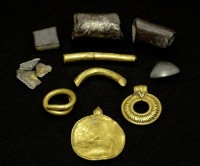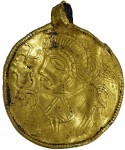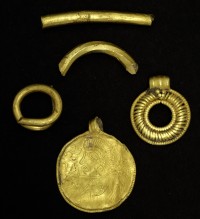 A rare ancient gold amulet decorated with the face of Odin has been discovered in Magletving on the Danish island of Lolland. Local metal detectorist Carsten Helm and his two young sons, Lauritz (10) and Luke (12), were scanning a field when they unearthed a small gold disk about two centimeters (.8 inches) in diameter, a type of medallion known as a bracteate. It has a loop at the top for hanging from a chain and is bordered with gold thread. The Helms continued to scan the field and within 130 square meters (1400 square feet) discovered another gold pendant, three gold pieces probably broken off of a necklace and several chunks of silver, likely fragments of jewelry that could be broken into smaller weights and used as currency.
A rare ancient gold amulet decorated with the face of Odin has been discovered in Magletving on the Danish island of Lolland. Local metal detectorist Carsten Helm and his two young sons, Lauritz (10) and Luke (12), were scanning a field when they unearthed a small gold disk about two centimeters (.8 inches) in diameter, a type of medallion known as a bracteate. It has a loop at the top for hanging from a chain and is bordered with gold thread. The Helms continued to scan the field and within 130 square meters (1400 square feet) discovered another gold pendant, three gold pieces probably broken off of a necklace and several chunks of silver, likely fragments of jewelry that could be broken into smaller weights and used as currency.
They reported their finds to the Museum Lolland-Falster. Museum experts tentatively dated the treasure to around the 6th century. That was a turbulent, dangerous time when people had good reason to bury their most precious belongings for their safety. There were also extreme weather events in the year 536 A.D., referred to in ancient sources as a gelid year without sun. Likely caused by a massive volcanic eruption or a meteor strike throwing up so much ash it darkened the skies, the year of darkness devastated crops and caused widespread famine, especially in the north. Such a calamity might inspire terrifying comparisons to the Norse myth of Ragnarök, the destruction of the world in which the sun turns black and the “Mighty Winter” descends. The treasure could have been an offering to the gods, perhaps even by a single person, to ask for their protection from marauders or the end of the world.
 It’s the gold amulet that is the most exciting piece to archaeologist. On the front of the disk the large face of a man takes up most of the space. Beneath it is a horse and to the side is a left-facing swastika, believed to be a solar symbol in pre-Christian northern Europe. The face is identified as Odin’s because the iconography has been found on other bracteates accompanied by the runic phrase “The High One,” one of the nicknames for the Norse god of war and king of Asgard.
It’s the gold amulet that is the most exciting piece to archaeologist. On the front of the disk the large face of a man takes up most of the space. Beneath it is a horse and to the side is a left-facing swastika, believed to be a solar symbol in pre-Christian northern Europe. The face is identified as Odin’s because the iconography has been found on other bracteates accompanied by the runic phrase “The High One,” one of the nicknames for the Norse god of war and king of Asgard.
What makes it particularly compelling is that it is an extremely early depiction of a subject from Norse religion. It may be presenting Odin in his role as a shaman. The shaman’s soul journeys through the world of the spirits, represented by animals like birds, fish and horses. Odin’s face hovering over the horse could therefore be a representation of Odin’s soul traveling to the spirit world. Another possible interpretation is that this is Odin represented as a horse doctor. One of his magical attributes was the ability to heal sick horses. In more detailed scenes with this iconography, Odin touches the horse with his hand and foot, a laying on of limbs, as it were, to convey healing magic.
 This kind of Odin amulet is rare, with a total of about 1,000 having been found in northern Europe and only two others on Lolland. The last such amulet found on Lolland was discovered in 1906.
This kind of Odin amulet is rare, with a total of about 1,000 having been found in northern Europe and only two others on Lolland. The last such amulet found on Lolland was discovered in 1906.
The treasure is on display at the Maribo County Museum until December 20th. After that brief exhibition, the artifacts will be sent to the National Museum for further study and valuation as treasure trove. Once it is declared treasure trove, Carsten Helm and his sons will receive a finder’s fee that is at least the equivalent of the gold value.
To begin with, I recognized the head, a swastika, and a lyre. Then, the animal plus the ‘lyre’ appeared almost bovine to me. However, several ‘bracteates’ do in fact feature Odin with a horse, and indeed it seems to be a horse (+ doctor!). A young horse or ‘foal’ is also referred to as: ‘Füllen’, ‘Fyl’, or ‘Føl’. However, the ‘Second Merseburg Charm’ (manuscript, Fulda, 9th/10th century) reads:
Phôl ende Uuodan fuorun zi holza. dû wart demo balderes folon sîn fuoz birenkit. thû biguol en Sinthgunt, Sunna era swister, thû biguol en Frîja, Folla era swister; thû biguol en Wuodan, sô hê wola conda: sôse bênrenki, sôse bluotrenki, sôse lidirenki: bên zi bêna, bluot zi bluoda, lid zi geliden, sôse gelîmida sîn.
Phol [ᚨᛚᚢ?] and Odin were riding to the woods, when Balder’s foal’s foot was twisted. So conjured it Sinthgunt, Sunna’s sister, So conjured it Frija, Fulla’s sister, So conjured it Odin, as well he could: So bone-sprain, so blood-sprain, so joint-sprain: Bone to bone, blood to blood, joint to joint, so shall they be mended
:hattip:
They must have been Laughing Out Loud.